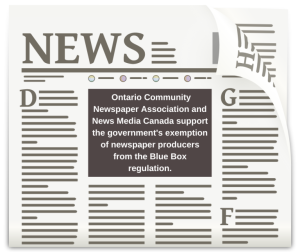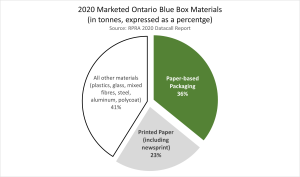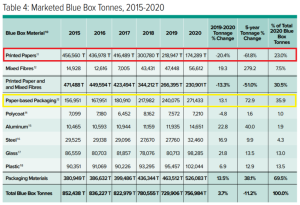The Government of Ontario made amendments to the Blue Box Regulation, which came into effect on April 14, 2022.
The amendments do not change the original intention of the regulation – to transition the existing Ontario Blue Box model from a shared funding model to a full producer responsibility model – and do not impact collection requirements, diversion outcomes, or key dates (transition will still begin July 1, 2023). The amendments were made to clarify the process for creating the province-wide system for collecting Blue Box materials. The key changes include:
- Removing the rule creation process, including the allocation table, from the regulation.
- Allowing producer responsibility organizations PROs to collaborate on a province-wide collection system; and requiring PROs that represent producers that supply more than 66% of Blue Box tonnes to submit an operational plan to RPRA for how they will operate the system by July 1, 2022.
- Exempting newspaper producers (whose supply accounts for at least 70% of their total Blue Box supply) from collection, management, and promotion and education requirements for two years; newspapers will remain an obligated material under the regulation, and will continue to be collected in the Blue Box system.
RPRA Webinar May 18
The Resource Productivity and Recovery Authority (RPRA), which is the regulator mandated by the government to enforce the province’s circular economy laws, is hosting a virtual Q&A for stakeholders on May 18 at 11:00am EST to review the amendments; to register click here.
Newspaper Associations Support Newspaper Exemption
On the news of newspaper producers being exempted from the Ontario Blue Box amended regulations, both the Ontario Community Newspaper Association (OCNA), who represent provincial community newspapers, and News Media Canada, the voice of the print and digital media industry in Canada, expressed their support for the government’s decision.

Alicia McCutcheon, president of the OCNA said: “We do applaud the Ford government for doing this… We’ve never viewed ourselves as the same as the tin can or the plastic wrap people of the world, we’re not packaging,” according to the National Post’s Newspaper lobby group ‘applauds’ exemption from Ontario’s new recycling program.
And Paul Deegan, president of News Media Canada, issued a statement:
“Canada’s newspaper publishers applaud the Ontario government’s leadership in recognizing that newspapers are not packaging and should be exempt from extended producer responsibility fees. We hope other provinces will follow Ontario’s lead in eliminating this punitive measure. The unintended consequence of EPR on newspapers is to reduce the number of pages in a newspaper or for the paper to simply close or go online only…. Newsprint has the highest level of collection of all recyclable materials, a stable end market, and high commercial value.”
Newsprint and the Ontario Blue Box Program
Stewardship Ontario’s 2020 Annual Report states that: “Historically, newspapers have represented a large volume of material in the Blue Box and, because of their high recycling rate, boosted the performance of the Blue Box program overall.”
In 2010, newsprint accounted for over 55% of the total Blue Box marketed tonnes, but it now makes up 23% of tonnage, according to RPRA’s 2020 Datacall.

Marketed tonnes represent the tonnage sorted and processed by a Material Recycling Facility, which are then baled, sold, and used in place of virgin materials.
Paper-based Packaging – which includes old corrugated cardboard, old boxboard and a portion of residential mixed papers and mixed fibres packaging – has the largest component of Ontario Blue Box marketed tonnes (271,433 tonnes), representing 35.9% of total Blue Box marketed tonnage (756,984).
As for the performance of Ontario’s Blue Box program, the 2019 recycling rate was 57.3%, down from 60.2% in 2018, the decline explained by Stewardship Ontario in their 2020 Annual Report:
“The reduction of newsprint, magazines and catalogues and other printed paper materials, along with higher residue rates and higher contamination standards imposed by end markets, are the main reasons for the overall decline in recycled tonnes.”
Table 4 of RPRA’s 2020 Datacall Report shows Marketed Blue Box Tonnes from 2015 to 2020, with Printed Papers – which includes newsprint, household fine paper, telephone books, and catalogues – showing a nearly 62% decline in tonnage over the five-year period; while Paper-based Packaging is up nearly 73% over the same period.

PPEC Commentary
It will take some time to understand the implications of the regulatory amendments, and any impacts they may have on the transition to a producer responsibility model for the Ontario Blue Box program. PPEC continues to remain concerned about the feasibility of meeting the paper targets under the new transitioned program, which we have previously written about. We will continue to monitor developments.
